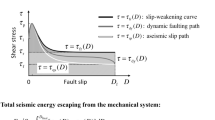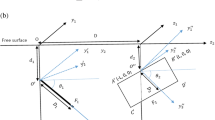Abstract
Using a differential form of the potential energy function and taking the effect of work applied by external force in far field into account, the mechanism of strike-slip fault earthquake is analyzed. The research indicates that each characteristic displayed with a fold catastrophe model in the catastrophe theory corresponds to a specific primary characteristic of the strike-slip fault earthquake. The fold catastrophe can describe the positions of starting and end points of a fault failure and the distance of fault dislocation. These include the description of stability of the surrounding rock-fault system before and after the earthquake. Two different illustrations about elastic energy releasing amount of the surrounding rock with the fault failure are shown with the primary characteristics mutually demonstrated. The intensity of strike-slip fault earthquake is related to the surrounding rock press and the stiffness ratio of surrounding rock and fault. The larger the surrounding rock press, the smaller the stiffness ratio. The larger the included angle between the tangential stress axis and the causative fault surface, the stronger the earthquake.
Similar content being viewed by others
References
Stuart, W. D. Quasi-static earthquake mechanics. Reviews of Geophysics and Space Physics 17(6), 1115–1120 (1979)
Stuart, W. D. Strain softening instability model for the San Fernando earthquake. Science 203(4383), 907–910 (1979)
Rice, J. R. New perspectives in crack and fault dynamics. Proceedings of the 20th International Congress of Theoretical and Applied Mechanics (eds. Aref, H. and Phillips, J. W.), Kluwer Academic Publishers, Chicago, 1–24 (2001)
Rice, J. R. Constitutives relations for fault slip and earthquake instabilities. Pure and Applied Geophysics 121(3), 443–475 (1983)
Ben-Zion, Y. Dynamic rupture in recent models of earthquake faults. J. Mech. Phys. Solids 49(9), 2209–2244 (2001)
Kanamori, H. and Brodsky, E. E. The physics of earthquakes. Reports on Progress in Physics 67(8), 1429–1496 (2004)
Wei, F. L. Cepstrum analysis of seismic source characteristics. Acta Seismologica Sinica 16(1), 50–58 (2003)
Wang, R. Q., Jia, X. F., and Hu, T. Y. The precise finite difference method for seismic modeling. Applied Geophysics 1(2), 69–74 (2004)
Yin, Y. Q. and Zheng, G. T. A cusp type catastrophic model of fault earthquake (in Chinese). Acta Geophysica Sinica 31(6), 657–664 (1988)
Yong, X. X., Yin, Y. Q., Kang, Z. Y., Liu, G. X., Wang, T. T., Chen, R. J., and Zhang, Y. S. The cusp type catastrophe analyses of compresso-shear fault earthquake (in Chinese). Science in China (Series B) 24(6), 656–663 (1994)
Karcinovic, D. Statistical aspects of the continuous damage theory. Int. J. Solids Struct. 18(3), 551–562 (1982)
Kachanov, L. M. Fundamentals of the Theory of Plasticity (in Chinese) (Transl. Zhou, H. T.), People’s Education Press, Beijing, 147–148 (1982)
Zheng, Y. T. Fundamentals of Elastic-Plastic-Sticky Theory of Rock Mechanics (in Chinese), China Coal Industry Publishing House, Beijing (1988)
Ling, F. H. History, present and advances of the catastrophe theory (in Chinese). Advances in Mechanics 14(4), 289–403 (1984)
Cook, N. G. W. The failure of rock. Int. J. Rock Mech. Min. Sci. 2(3), 389–403 (1965)
Chen, Y. Mechanical Properties of Crustal Rock (in Chinese), Earthquake Press, Beijing (1988)
Author information
Authors and Affiliations
Corresponding author
Additional information
Communicated by Li-qun CHEN
Project supported by the National Natural Science Foundation of China (No. 5067059)
Rights and permissions
About this article
Cite this article
Pan, Y., Li, Aw. Fold catastrophe model of strike-slip fault earthquake. Appl. Math. Mech.-Engl. Ed. 31, 349–362 (2010). https://doi.org/10.1007/s10483-010-0308-9
Received:
Revised:
Published:
Issue Date:
DOI: https://doi.org/10.1007/s10483-010-0308-9
Key words
- fault earthquake
- fold catastrophe model
- end point of failure
- failure criterion
- energy import rate
- elastic energy releasing amount




